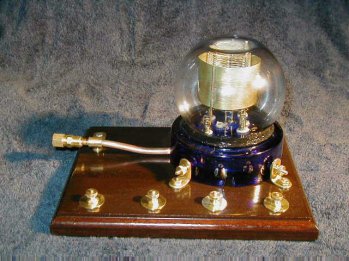 While ragchewing with Joe Flamini earlier today, we got on the topic of whether or not it would be possible to make a usable transistor in your basement. It’s not a cakewalk, but a fair number of people have made their own vacuum tubes at home. I myself have made a sort of point-contact diode using a chunk of galena (lead sulphide) crystal and a piece of #44 wire–it’s what the old guys used to call a cat’s whisker detector. Like a lot of guys, I added a second whisker and thought it might become a point-contact transistor, but I didn’t know how to test it. (And that was in 1964.)
While ragchewing with Joe Flamini earlier today, we got on the topic of whether or not it would be possible to make a usable transistor in your basement. It’s not a cakewalk, but a fair number of people have made their own vacuum tubes at home. I myself have made a sort of point-contact diode using a chunk of galena (lead sulphide) crystal and a piece of #44 wire–it’s what the old guys used to call a cat’s whisker detector. Like a lot of guys, I added a second whisker and thought it might become a point-contact transistor, but I didn’t know how to test it. (And that was in 1964.)
There’s a kind of early junction transistor called a “meltback” that starts with a small germanium bar. You heat one end until it melts a little, and as it hardens and recrystallizes after heat is removed, P-dopants gather somehow in the zone between the melted and unmelted germanium, and what results is an NPN transistor. I read years ago of somebody making meltback transistors in his basement, but I can’t find the reference now. I guess the hard part is just laying hands on a piece of germanium with both dopants in it. This article describes a number of ways that transistors are made, including the meltback method. None of them seem difficult from a lab technique standpoint, but there’s always the question of just where you get a little indium when you need it.
While researching the question I came across the Web site of H. P. Friedrichs AC7ZL, who wrote a book some years ago about making tubes and transistors at home. The book is called Instruments of Amplification, and used copies are available for about $25 on Amazon. I don’t have it yet, but I want to call your attention to the author’s online photo albums, which show some of the devices that he’s built. They’re beautifully photographed, and definitely show some steampunk influence. Here’s Album 1, and Album 2.
A fair number of people were stumbling around in the dark pursuing solid-state active devices as early as 1910; here’s a good overview. So not only was it possible for the Edwardians to make transistors, some actually came pretty close to doing it. The problem was not even access to materials–pure germanium had been available since the late 1880s–but simply that the physics was still obscure. A suitably intuitive scientist who understood electricity as well as it was understood in 1890 could have worked out PN junction physics. The fact that nobody did could have been simple bad luck: The right guy with the right background and the right obsessions working in the right lab with the right tools and the right materials just didn’t turn up.
While we talking steampunk, few are aware that a purely steam-powered biplane flew successfully in the early 1930s. It had a interesting characteristic: It was quiet. Internal combustion is nothing more than a continuous series of explosions inside a piston. Generate your pressure some other way, and the sound level goes way down. There’s some period b/w silent footage on YouTube. The engine could be quickly and easily reversed, though it’s not clear to me how valuable that would be in a biplane.
Steam-powered aircraft interest me because there’s nothing essentially electrical about a steam engine. In my novel The Cunning Blood I suggested that all aircraft on Hell (a prison planet seeded with nanomachines that homed in on and destroyed electrical conductors) would be either Diesel or turbojet powered, simply because I didn’t think you could make a steam engine that was both powerful enough and light enough to fly. I guess I was wrong.
Heh. I love to be wrong!











